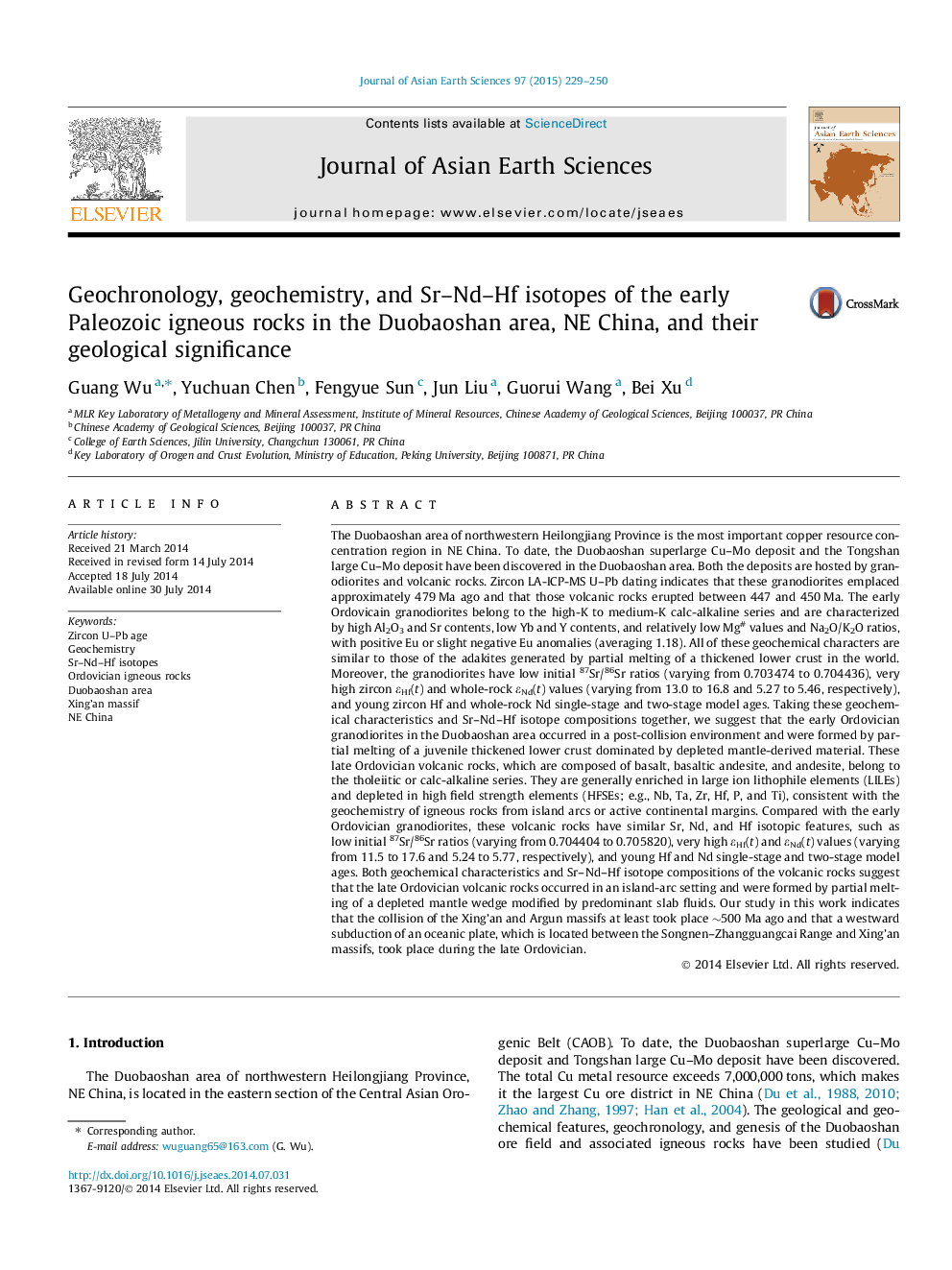| کد مقاله | کد نشریه | سال انتشار | مقاله انگلیسی | نسخه تمام متن |
|---|---|---|---|---|
| 4730435 | 1356758 | 2015 | 22 صفحه PDF | دانلود رایگان |

• The Duobaoshan granodiorites formed approximately 479 Ma ago.
• The formation age of the Duobaoshan Formation volcanic rocks is 447–450 Ma.
• The granodiorites were formed by partial melting of a juvenile thickened lower crust.
• The volcanic rocks were formed by partial melting of a depleted mantle wedge.
• Both the Duobaoshan and the Tongshan deposits formed after 447 Ma but before 219 Ma.
The Duobaoshan area of northwestern Heilongjiang Province is the most important copper resource concentration region in NE China. To date, the Duobaoshan superlarge Cu–Mo deposit and the Tongshan large Cu–Mo deposit have been discovered in the Duobaoshan area. Both the deposits are hosted by granodiorites and volcanic rocks. Zircon LA-ICP-MS U–Pb dating indicates that these granodiorites emplaced approximately 479 Ma ago and that those volcanic rocks erupted between 447 and 450 Ma. The early Ordovicain granodiorites belong to the high-K to medium-K calc-alkaline series and are characterized by high Al2O3 and Sr contents, low Yb and Y contents, and relatively low Mg# values and Na2O/K2O ratios, with positive Eu or slight negative Eu anomalies (averaging 1.18). All of these geochemical characters are similar to those of the adakites generated by partial melting of a thickened lower crust in the world. Moreover, the granodiorites have low initial 87Sr/86Sr ratios (varying from 0.703474 to 0.704436), very high zircon εHf(t) and whole-rock εNd(t) values (varying from 13.0 to 16.8 and 5.27 to 5.46, respectively), and young zircon Hf and whole-rock Nd single-stage and two-stage model ages. Taking these geochemical characteristics and Sr–Nd–Hf isotope compositions together, we suggest that the early Ordovician granodiorites in the Duobaoshan area occurred in a post-collision environment and were formed by partial melting of a juvenile thickened lower crust dominated by depleted mantle-derived material. These late Ordovician volcanic rocks, which are composed of basalt, basaltic andesite, and andesite, belong to the tholeiitic or calc-alkaline series. They are generally enriched in large ion lithophile elements (LILEs) and depleted in high field strength elements (HFSEs; e.g., Nb, Ta, Zr, Hf, P, and Ti), consistent with the geochemistry of igneous rocks from island arcs or active continental margins. Compared with the early Ordovician granodiorites, these volcanic rocks have similar Sr, Nd, and Hf isotopic features, such as low initial 87Sr/86Sr ratios (varying from 0.704404 to 0.705820), very high εHf(t) and εNd(t) values (varying from 11.5 to 17.6 and 5.24 to 5.77, respectively), and young Hf and Nd single-stage and two-stage model ages. Both geochemical characteristics and Sr–Nd–Hf isotope compositions of the volcanic rocks suggest that the late Ordovician volcanic rocks occurred in an island-arc setting and were formed by partial melting of a depleted mantle wedge modified by predominant slab fluids. Our study in this work indicates that the collision of the Xing’an and Argun massifs at least took place ∼500 Ma ago and that a westward subduction of an oceanic plate, which is located between the Songnen–Zhangguangcai Range and Xing’an massifs, took place during the late Ordovician.
Journal: Journal of Asian Earth Sciences - Volume 97, Part B, 1 January 2015, Pages 229–250